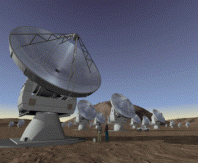Tasks of the IRAM ARC node
The IRAM ARC node shall provide user support services, including user formation (specialized schools) and face-to-face support (on the basis of the existing Plateau de Bure support). We will also be working on a number of new developments, aimed at developing or optimizing new observational or data reduction techniques. Finally, IRAM is also involved in a number of ALMA core activities, as the development of the telescope calibration software or the participation to the ALMA commissionning.
 |
Until
ALMA is operational, one
of the main
goal of the IRAM ARC node is to form and train new users to the
millimeter-interferometry
techniques. The Plateau
de Bure
interferometer is obviously a
major asset to form future ALMA users, both technically and
scientifically. IRAM is also organizing
a series of millimeter-interferometry
schools, that are taking place every two years since 1998.
Next event: the 6th IRAM millimeter-interferometry school will be held in Grenoble, October 6-10th 2008.
Next event: the 6th IRAM millimeter-interferometry school will be held in Grenoble, October 6-10th 2008.
Once ALMA data are available, providing face-to-face support for data reduction will be one of the key activity of the IRAM ARC node. The system in place for more than 10 years for the Plateau de Bure interferometer will be extended to ALMA: each project will have a local contact, i.e. an astronomer who is expert in the instrument and data reduction software and available to provide support and help. The PI of the project will be encouraged to travel to Grenoble to spend a few days to reduce and analyse the data with his/her local contact. We still have to work out the organizational details.
Travel funding for astronomers visiting Grenoble will be available, following the same rules as the current ones for the Plateau de Bure: one trip, two people per project. Only scientists affiliated to the IRAM funding agencies are elligible for this financial support.
The face-to-face support shall be in place for the ALMA Early Science observations. The first call for proposal for the Early Science could be in the second part of 2010, with the Early Science observations starting end of 2010 or beginning of 2011.
Using as much as possible synergies with the Plateau de Bure interferometer, ALMA-related projects are and will be supported, aimed at developing or optimizing new observational or data reduction techniques. IRAM's expertise covers various aspects from calibration (millimeter data processing, atmopsheric calibration, phase correction using WVR, pipeline) or imaging (deconvolution techniques, mosaicing, short-spacings inclusion). Work on special observing techniques such as VLBI, astrometry, or polarimetry is also taking place in the institute.
Ongoing ALMA-related projects: (as of May 2008)
- On-the-fly observations. We
are working on the development and validation of an on-the-fly
interferometric observing technique (continuous motion of the antennas
during data acquisition, instead of the classical stop-and-go
mosaicing technique). The major difficulty is the data
processing and new algorithms must be developed. This project is funded
by
the FP6 "ALMA enhancement" program; phase 1 is the validation of the
OTF method with the Plateau de Bure; phase 2 is the implementation in
the ALMA software environment. People
involved: N.Rodriguez, E.Reynier,
F.Gueth,
J.Pety,
- pyGILDAS. A Python interface to GILDAS has been developed and is currently being finalized. It is available in the GILDAS distribution, although on an experimental basis (see documentation). The user can access the GILDAS functionalities from the SIC or from the Python monitor. The goal is to have an interoperability between the GILDAS and CASA software, allowing scientists to work in a single environment and use both packages to reduce and analyse their data. It is also a way to smooth the transition from GILDAS to CASA for IRAM users. People involved: S.Bardeau, J.Pety, S.Guilloteau (Obs. Bordeaux).
- Holographies. The
software used by ALMA for all antenna surface measurements (holography
measurements) is the Plateau de Bure software (CLIC). We will
further
develop and maintain this tool. People
involved: R.Lucas, V,Pietu,
F.Gueth.
- ALMA simulator. The GILDAS package includes a full imaging simulator of ALMA. See ALMA memo 398 for details. This simulator will be updated and further developed.
- CASA tests. We are starting to get acquainted with the CASA software. Software allowing to write/read Plateau de Bure data in/from the ASDM format is now available and a series of tests of CASA using Plateau de Bure data will happen soon.
The IRAM ARC node intends to participate to the ALMA commissioning. Two astronomers from IRAM are joining ESO to integrate the Commissioning Team in Chile. Other astronomers will do short- to medium duration stays at the OSF to participate to the commissioning.
IRAM is developping software for ALMA, under contract with ESO. Strictly speaking, this is not part of the ARC, as it is funded by the construction budget of ALMA. We consider it however as a key activity to develop in-house expertise on the ALMA instrument and data processing software.
- Telescope Calibration software. This software performs the real-time calibration of the instrument: automatic reduction of the pointing, focussing, delay measurement, baseline measurement, etc. It also computes and applies the real-time atmospheric phase correction from the ALMA WVR measurement. It is currently used at the ATF and will be a key element during the ALMA commissioning phase. People involved: R.Lucas, D.Broguiere, J.C.Roche.
- Science Software Requirement
group. IRAM astronomers are
participating to this group, which was in charge of developping the
scientific requirements for the ALMA software, and
is now deeply involved in the software testing and evaluation. People involved: R.Lucas, R.Neri, P.Salome.